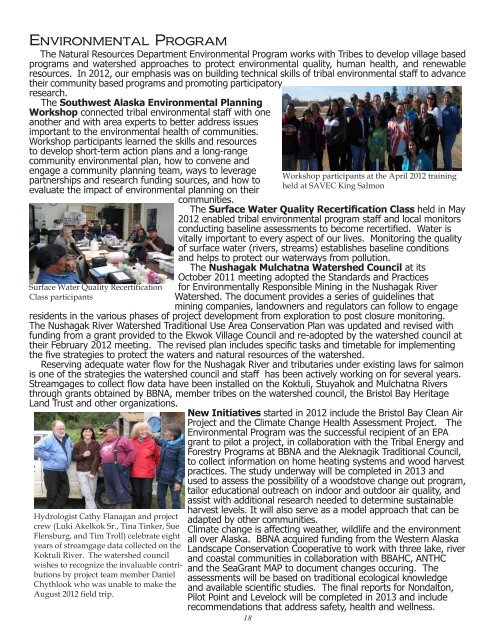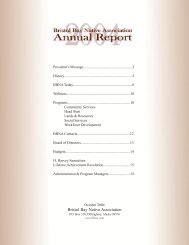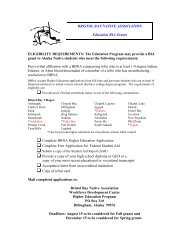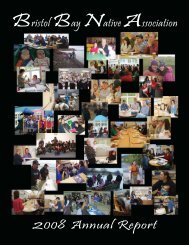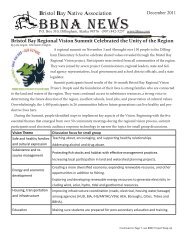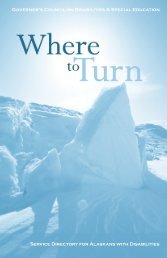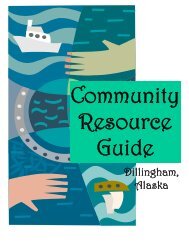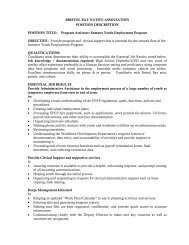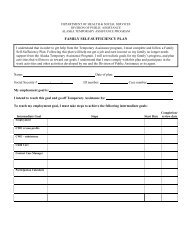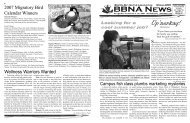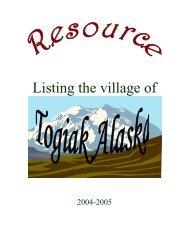2012 Annual Report - Bristol Bay Native Association
2012 Annual Report - Bristol Bay Native Association
2012 Annual Report - Bristol Bay Native Association
You also want an ePaper? Increase the reach of your titles
YUMPU automatically turns print PDFs into web optimized ePapers that Google loves.
Environmental Program<br />
The Natural Resources Department Environmental Program works with Tribes to develop village based<br />
programs and watershed approaches to protect environmental quality, human health, and renewable<br />
resources. In <strong>2012</strong>, our emphasis was on building technical skills of tribal environmental staff to advance<br />
their community based programs and promoting participatory<br />
research.<br />
The Southwest Alaska Environmental Planning<br />
Workshop connected tribal environmental staff with one<br />
another and with area experts to better address issues<br />
important to the environmental health of communities.<br />
Workshop participants learned the skills and resources<br />
to develop short-term action plans and a long-range<br />
community environmental plan, how to convene and<br />
engage a community planning team, ways to leverage<br />
partnerships and research funding sources, and how to<br />
evaluate the impact of environmental planning on their<br />
communities.<br />
Surface Water Quality Recertification<br />
Class participants<br />
Workshop participants at the April <strong>2012</strong> training<br />
held at SAVEC King Salmon<br />
The Surface Water Quality Recertification Class held in May<br />
<strong>2012</strong> enabled tribal environmental program staff and local monitors<br />
conducting baseline assessments to become recertified. Water is<br />
vitally important to every aspect of our lives. Monitoring the quality<br />
of surface water (rivers, streams) establishes baseline conditions<br />
and helps to protect our waterways from pollution.<br />
The Nushagak Mulchatna Watershed Council at its<br />
October 2011 meeting adopted the Standards and Practices<br />
for Environmentally Responsible Mining in the Nushagak River<br />
Watershed. The document provides a series of guidelines that<br />
mining companies, landowners and regulators can follow to engage<br />
residents in the various phases of project development from exploration to post closure monitoring.<br />
The Nushagak River Watershed Traditional Use Area Conservation Plan was updated and revised with<br />
funding from a grant provided to the Ekwok Village Council and re-adopted by the watershed council at<br />
their February <strong>2012</strong> meeting. The revised plan includes specific tasks and timetable for implementing<br />
the five strategies to protect the waters and natural resources of the watershed.<br />
Reserving adequate water flow for the Nushagak River and tributaries under existing laws for salmon<br />
is one of the strategies the watershed council and staff has been actively working on for several years.<br />
Streamgages to collect flow data have been installed on the Koktuli, Stuyahok and Mulchatna Rivers<br />
through grants obtained by BBNA, member tribes on the watershed council, the <strong>Bristol</strong> <strong>Bay</strong> Heritage<br />
Land Trust and other organizations.<br />
New Initiatives started in <strong>2012</strong> include the <strong>Bristol</strong> <strong>Bay</strong> Clean Air<br />
Project and the Climate Change Health Assessment Project. The<br />
Environmental Program was the successful recipient of an EPA<br />
grant to pilot a project, in collaboration with the Tribal Energy and<br />
Forestry Programs at BBNA and the Aleknagik Traditional Council,<br />
to collect information on home heating systems and wood harvest<br />
practices. The study underway will be completed in 2013 and<br />
used to assess the possibility of a woodstove change out program,<br />
tailor educational outreach on indoor and outdoor air quality, and<br />
assist with additional research needed to determine sustainable<br />
Hydrologist Cathy Flanagan and project<br />
crew (Luki Akelkok Sr., Tina Tinker, Sue<br />
Flensburg, and Tim Troll) celebrate eight<br />
years of streamgage data collected on the<br />
Koktuli River. The watershed council<br />
wishes to recognize the invaluable contributions<br />
by project team member Daniel<br />
Chythlook who was unable to make the<br />
August <strong>2012</strong> field trip.<br />
harvest levels. It will also serve as a model approach that can be<br />
adapted by other communities.<br />
Climate change is affecting weather, wildlife and the environment<br />
all over Alaska. BBNA acquired funding from the Western Alaska<br />
Landscape Conservation Cooperative to work with three lake, river<br />
and coastal communities in collaboration with BBAHC, ANTHC<br />
and the SeaGrant MAP to document changes occuring. The<br />
assessments will be based on traditional ecological knowledge<br />
and available scientific studies. The final reports for Nondalton,<br />
Pilot Point and Levelock will be completed in 2013 and include<br />
recommendations that address safety, health and wellness.<br />
18


